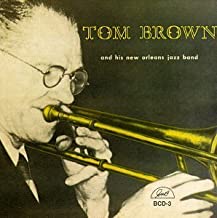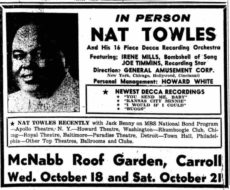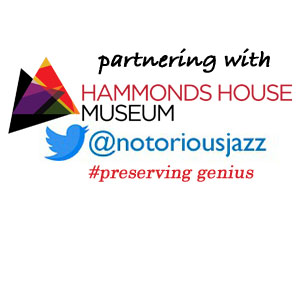
Daily Dose Of Jazz…
Tom Brown was born in Uptown New Orleans, Louisiana on June 3, 1888. He played trombone with the bands of Papa Jack Laine and Frank Christian, and by 1910 he was usually working with leading bands under his own name. The band played in a style then locally known as “hot ragtime” or “ratty music”. In early 1915, his band was heard by Vaudeville dancer Joe Frisco who then arranged a job for Brown’s band in Chicago, Illinois.
Tom Brown’s Band from Dixieland opened up at Lamb’s Cafe in Chicago, this band seems to be the first to be popularly referred to as playing Jass. The term jass, at that time, had a sexual connotation, which drew more people to come to hear the band out of curiosity. Realizing the publicity potential he started calling his group Brown’s Jass Band.
Heading to Chicago, Illinois he enjoyed over four months of success there before moving to New York City, where they played for an additional four months more prior to returning to New Orleans in 1916. Once home, Tom immediately put together another band with Larry Shields, Alcide Nunez, and Ragbaby Stevens, then went to work for Bert Kelly in New York City, replacing the Original Dixieland Jass Band at Reisenweber in 1918. He started doing freelance recording work with New York dance and novelty bands, then joined the band of Harry Yerkes.
Brown also played the Vaudeville circuit in the acts of Joe Frisco and Ed Wynn. Late 1921 he returned to Chicago and joined Ray Miller’s Black & White Melody Boys, with whom he made more recordings. During this period he also co-lead a dance band with his brother Steve. Back in New Orleans he played with Johnny Bayersdorffer and Norman Brownlee’s bands, making a few excellent recordings.
During the Great Depression he supplemented his income from music by repairing radios. He opened up a music shop and a junk shop on Magazine Street. He played string bass in local swing and dance bands. With the revival of interest in traditional jazz he played in various Dixieland bands in the 1950s. Making his last recording just weeks before his death, his trombone playing apparently did not suffer from the fact that he had neither teeth or dentures at the time. Trombonist Tom Brown, who also played string bass, passed away in New Orleans on March 25, 1958.
More Posts: bandleader,history,instrumental,jazz,string bass,trombone

Daily Dose Of Jazz…
Nat Towles was born on August 10, 1905 in New Orleans, Louisiana the son of string bassist Phil “Charlie” Towles. Starting his musical career as a guitarist and violinist at the age of 11, he switched to the bass at the age of 13. Performing in New Orleans through his teenage years with Gus Metcalf’s Melody Jazz Band, he eventually played with a number of bands, including those of Buddie Petit, Henry “Red” Allen, Jack Carey, and the Original Tuxedo Jazz Orchestra.
In 1923 he formed The Nat Towles’ Creole Harmony Kings and this jazz band became one of the prominent territory bands in Texas, Oklahoma, Kansas, and Nebraska. By 1925 he was playing bass for Fate Marable, and the following year reformed his own band. 1934 saw him organizing a band of young musicians studying music at Wiley College in Austin, Texas.
Nat worked a club circuit in Dallas during this period, reportedly for a gangster who owned 26 nightclubs throughout the city. During this period T-Bone Walker and Buddy Tate worked for him. During the 1930s he transformed his band into The Nat Towles Dance Orchestra, signed with the National Orchestra Service, and focused on swing music through the 1930s and 1940s.
In 1934 Towles took up residence in North Omaha, Nebraska, where his band was stationed for the next 25 years. With this outfit he dueled with Lloyd Hunter for dominance over the much-contested Near North Side in North Omaha, where he was held over at the Dreamland Ballroom for several weeks. In 1936 and 1937 his band held residence at Omaha’s Krug Park.
In 1943 he also held a three-month stint at the Rhumboogie Club in Chicago, and later that year took up residency again with Billy Mitchell in tow in Omaha’s Dreamland Ballroom. He went on to play extensively throughout New York City, playing with trombonist Buster Cooper, saxophonists Red Holloway, Buster Bennett and Preston Love.
As their bandleader, Towles is credited with influencing a variety of musicians including Sir Charles Thompson and Neal Hefti, as well as superior saxophonists Jimmy Heath, Oliver Nelson and Paul Quinichette. As an educator he influenced many younger musicians such as pianist Duke Groner and trombonist Buddy McLewis, aka Joe McLewis.
Continuing to lead bands throughout the 1950s, in 1959 he retired to California and opened a bar. Bassist, guitarist and violinist Nat Towles, who feared the limelight would steal away his best players thus never sought national recognition and leaving no known recordings, passed away in January of 1963 in Berkeley, California of a heart attack.

Give A Gift Of Jazz – Share
![]()
More Posts: guitar,string bass,violin


